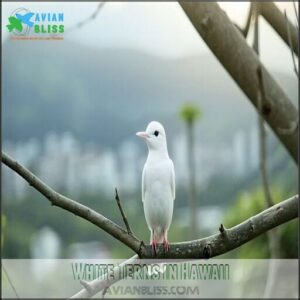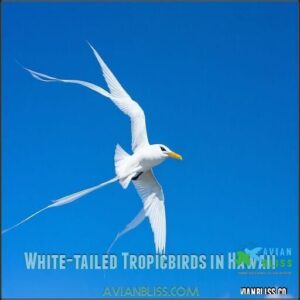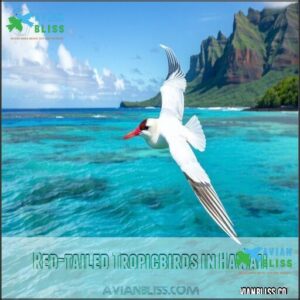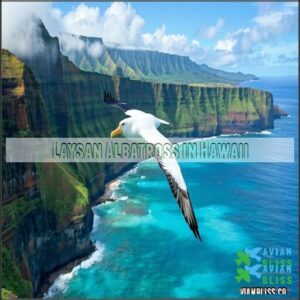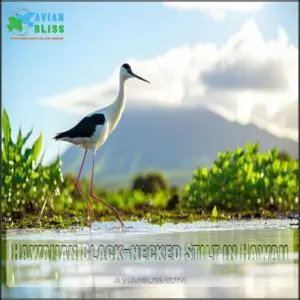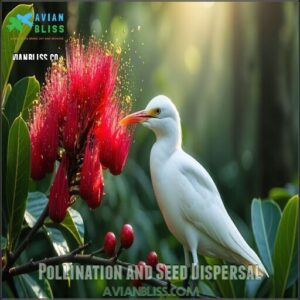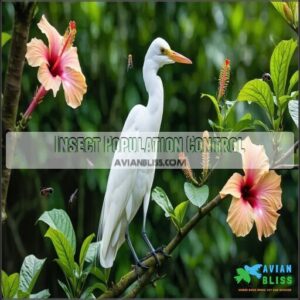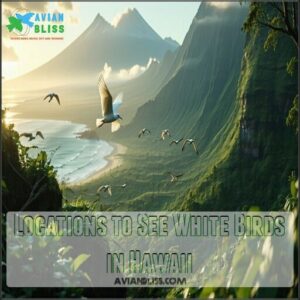This site is supported by our readers. We may earn a commission, at no cost to you, if you purchase through links.

The graceful White Tern (Manu-o-Kū) floats through Honolulu like a feathered ghost, while massive Laysan Albatrosses showcase impressive 6-foot wingspans on Kauai’s coastlines.
Don’t miss the elegant White-tailed Tropicbird with its distinctive streaming tail, or the partly white Hawaiian Black-necked Stilt balancing on impossibly thin legs in wetlands.
These birds aren’t just beautiful—they’re essential environmental indicators and culturally significant to native Hawaiians, playing a crucial role in the ecosystem as native Hawaiians view them.
The best viewing spots often hide in plain sight, just waiting for your patient observation.
Table Of Contents
- Key Takeaways
- Types of White Birds in Hawaii
- Ecological Roles of White Birds
- Characteristics of White Birds
- White Bird Habitats in Hawaii
- Breeding and Nesting Habits
- Migration Patterns of White Birds
- White Bird Viewing in Hawaii
- Conservation of White Birds
- Conservation Efforts and Challenges
- Locations to See White Birds in Hawaii
- Frequently Asked Questions (FAQs)
- What are the little white birds in Hawaii?
- What is the white seabird in Oahu?
- Are egrets invasive to Hawaii?
- What are those white birds called?
- Are egrets invasive in Hawaii?
- What is the endangered white bird in Hawaii?
- What is the white birds called?
- Are there white birds in Hawaii?
- Which seabirds live in Hawaii?
- What birds live in Hawaii?
- Conclusion
Key Takeaways
- You’ll find several stunning white birds in Hawaii including the graceful White Tern (Manu-o-Kū) in Honolulu, the massive Laysan Albatross with 6-foot wingspans on Kauai, and the White-tailed Tropicbird with its distinctive streaming tail.
- These birds aren’t just beautiful—they’re essential environmental indicators and culturally significant to native Hawaiians, playing crucial roles in pollination, seed dispersal, insect control, and maintaining marine food chains.
- For the best viewing experience, visit prime locations like Kahana State Park on Oahu, Kilauea Point Wildlife Refuge on Kauai, or Waihee Coastal Dunes on Maui during early mornings or late afternoons.
- Conservation efforts are vital as these birds face threats from habitat loss, invasive predators like rats and cats, climate change, and human disturbance—responsible tourism and awareness can help protect these magnificent creatures.
Types of White Birds in Hawaii
Hawaii is home to a fascinating variety of white birds, each with unique features and roles in the ecosystem.
From the graceful White Tern to the striking Red-tailed Tropicbird, these species highlight the islands’ remarkable biodiversity.
White Terns in Hawaii
The white tern (Gygis alba), or Manu-O-Ku, is one of the most enchanting white birds in Hawaii. Known for urban nesting on bare branches in Honolulu, they’ve adapted uniquely to city life.
These Hawaii white birds symbolize cultural significance and resilience.
Fascinating traits include:
- Habitat: Urban areas, especially in Oahu.
- Nesting: Lays eggs without nests.
- Diet Details: Eats small fish and squid.
- Conservation Status: Protected under U.S. laws.
- Symbolism: Represents peace and harmony.
White-tailed Tropicbirds in Hawaii
Hawaii’s WhiteTailed Tropicbird sweeps the sky like a tropical kite, showcasing its dazzling plumage variations.
With tail feathers extending like ribbons, it maneuvers effortlessly through its flight patterns. These seabirds nest on secluded cliffs, offering safety for chick development.
Here’s why they’re mesmerizing:
- Striking features: Sleek white bodies with long tails.
- Feeding habits: Skilled hunters of fish and squid.
- Role: Essential to seabirds Hawaii ecosystems.
Red-tailed Tropicbirds in Hawaii
The Red-tailed Tropicbird (Phaethontidae) is a marvel among seabirds in Hawaii.
With its radiant plumage variations, striking red bill, and iconic tail morphology—long, elegant streamers—this bird stands out against the Hawaiian skies.
Known for their acrobatic courtship, they perform aerial flips paired with distinct calls.
Their foraging range spans tropical waters, diving to catch fish and squid.
Nesting on cliffs and coral islands, they face threats like habitat loss and invasive predators.
However, conservation successes, including habitat restoration and predator control, have boosted their numbers.
If you’re into Hawaii bird sightings, keep an eye out near their protected nesting sites during breeding season!
Laysan Albatross in Hawaii
The Laysan Albatross is an awe-inspiring feature of Hawaii’s skies, gliding effortlessly with its 2.5-meter wingspan.
These coastal birds nest on islands and atolls, laying a single egg annually.
- Learn about their Nesting Behavior in sanctuaries.
- Support Albatross Conservation efforts to protect them.
- Understand their Feeding Habits through studies.
- Help mitigate Threats Faced from invasive species.
Little Tern in Hawaii
The Little Tern, a tiny marvel among coastal birds in Hawaii, thrives with daring plunge-dives to catch fish mid-wave.
Found near sandy beaches, its delicate nesting sites face habitat pressures, emphasizing the need for Tern Conservation initiatives.
Spotting this agile hunter during Hawaii birdwatching reveals its charm and resilience, showcasing why protecting these white birds in Hawaii matters and highlighting the importance of preserving their habitat for conservation.
Masked Booby in Hawaii
The Masked Booby, a standout member of the Sulidae family, dazzles with its snowy white plumage and striking black mask.
Known for dramatic dives into Hawaii’s coastal waters, it’s a favorite among Hawaii birdwatching enthusiasts.
These coastal birds prefer nesting on ocean cliffs, making ground scrapes their homes.
- Wingspan: Over 6 feet for efficient gliding.
- Feeding Ecology: Diet includes squid and small fish caught mid-dive.
- Nesting Behavior: Simple nests on cliff edges.
- Conservation Status: Dependent on healthy marine ecosystems.
- Threats Faced: Habitat disturbance and declining fish populations challenge survival.
Hawaiian Black-necked Stilt in Hawaii
The Hawaiian Black-necked Stilt, a striking wetland bird with long pink legs and elegant black-and-white plumage, thrives in Hawaii’s shallow waters.
It feeds on insects, crustaceans, and fish while its high-pitched calls fill the air during nesting.
| Stilt Features | Details |
|---|---|
| Habitat | Wetlands, mudflats, ponds |
| Diet | Insects, fish, crustaceans |
| Conservation Focus | Habitat restoration efforts |
Protecting wetlands guarantees these coastal birds benefit both ecosystems and bird conservation in Hawaii.
Ecological Roles of White Birds
White birds in Hawaii play essential roles in maintaining healthy ecosystems, from controlling insect populations to supporting food chains.
Their behaviors and interactions impact everything from coastal habitats to agricultural areas, showcasing their importance to the environment.
They have a significant effect on the ecosystem, and their presence is vital for a healthy balance.
Pollination and Seed Dispersal
In Hawaii, white birds play a vital role as nature’s gardeners, assisting in the growth of native plants.
Through wetland pollination and avian seed carriers, they support life in coastal ecosystems and beyond. Their droppings act as seed dispersal mechanisms, spreading plant species across the islands.
These bird-plant interactions preserve ecological balance, ensuring the Hawaiian Islands remain thriving and biodiverse.
Here’s how they contribute:
- Pollinate native flowers, keeping them blooming.
- Disperse seeds to expand habitats naturally.
- Support plant survival in fragile ecosystems.
- Enhance biodiversity in Hawaiian landscapes.
Insect Population Control
White birds in Hawaii are nature’s pest controllers, using their diets to support insect population control and ecosystem balance.
Their role as natural pesticides helps curb pest resistance and boosts agricultural benefits without relying on chemicals.
- Reduce invasive and native insect populations naturally.
- Aid local farms by cutting down pest damage.
- Maintain ecosystem balance while preserving Hawaii’s biodiversity.
- Keep Hawaii’s ecosystems healthy and sustainable with their unique insect control habits.
Marine and Coastal Ecosystems
White birds in Hawaii, like white terns and white tropicbirds, are essential guardians of marine ecosystems. Their presence often signals ecosystem health, reminding us how interconnected our oceans and coasts truly are.
These coastal birds enhance coastal conservation by maintaining balance and stability within the marine foodwebs.
Here’s how they contribute:
- Regulate fish populations, ensuring sustainable stocks.
- Protect critical coastal habitats through careful foraging.
- Support habitat restoration by dispersing nutrients.
- Highlight pollution impacts, acting as environmental indicators.
White birds Hawaii natives, such as the graceful white tern Hawaii or white tropicbird, quietly uphold the resilience of fragile coastal ecosystems.
Maintaining The Food Chain
White birds in Hawaii are key players in the marine food chain, ensuring predator-prey balance and maintaining ecosystem stability.
By feeding on fish and squid, they regulate populations and support nutrient cycling.
Habitat loss effects and invasive species impact these roles, making conservation priorities essential for preserving marine ecosystems and keeping Hawaii’s delicate food web thriving and interconnected.
Cultural Significance
While soaring above the Aloha State, white birds in Hawaii, like the White Tern (manu-o-Kū), weave themselves into Hawaiian culture and history.
Their coloration, like that of many other species, can serve as effective camouflage in their environment.
These graceful birds aren’t just admired for their beauty; they hold deep cultural and spiritual meaning.
- Represent ancestral spirits and protection in Hawaiian symbolism.
- Linked to folklore connections as sacred bird deities.
- Seen as messengers of harmony and peace in native traditions.
- Prominently featured in artistic depictions of Hawaii’s natural world.
- Symbolize the connection between bird conservation and cultural heritage.
Their presence reflects Hawaii’s bond with nature, blending tradition, environmental care, and respect.
Characteristics of White Birds
You’ll notice white birds in Hawaii have evolved fascinating physical and behavioral traits that help them thrive in diverse habitats.
From lightweight bodies built for efficient flight to sharp eyesight aiding in hunting, their adaptations are perfectly suited to island life, with diverse habitats being a key factor.
Physical Characteristics of White Birds
Spotting white plumage birds in Hawaii is a treat for birdwatchers.
Each species is distinct in size, wing shape, feather coloration, and overall body design.
For instance, the White Tern’s slender beak complements its pure white feathers, adding to its elegance. The Masked Booby has bold black accents on its wings, enhancing its striking 67-inch wingspan.
Meanwhile, the short-legged Cattle Egret displays a mostly white body with a soft yellow beak.
| Bird Species | Feather Coloration | Wing Shape | Beak Morphology |
|---|---|---|---|
| White Tern | Pure white | Sleek, tapered | Slender, black |
| Masked Booby | White with black | Long, broad | Stout, pointed |
| Cattle Egret | White with orange | Short, rounded | Short, yellow |
| Laysan Albatross | White with gray | Long, narrow | Hooked, sturdy |
The distinct species and their unique characteristics make them a fascinating sight for bird enthusiasts, with the White Tern and Masked Booby being particularly notable examples.
Behavioral Traits of White Birds
White birds in Hawaii captivate with their fascinating bird behavior. From intricate mating rituals high in the sky to graceful foraging strategies like diving for fish, these white plumage birds are mesmerizing.
Their flight patterns reveal social behavior and playful interactions. Add their distinctive vocalizations, and you’ve got a symphony of sights and sounds perfect for bird identification and observation.
Their diverse behaviors include probing for insects to find food.
- Sky acrobatics enchant during courtship.
- Dives amaze during foraging.
- Playful flock dynamics engage.
- Calls beautifully harmonize communication.
Habitat and Distribution of White Birds
Across Hawaii, white birds call diverse habitats home.
Coastal distribution spans wetlands, ocean cliffs, and even urban areas.
Forest habitats showcase island endemism, where birds like White Terns nest on bare branches.
Altitudinal range varies, with Hawaiian Petrels favoring high elevations, while introduced species like Cattle Egrets stick to pastures.
Coastal birds in Hawaii, such as the Red-tailed Tropicbird, thrive along cliffs, reflecting the essential role habitats play in bird distribution and survival.
Diet and Foraging Habits of White Birds
In the context of hunting for food, white birds in Hawaii showcase incredible strategies suited to their surroundings.
Each species has its unique approach:
- Prey Selection: White Terns dive swiftly to catch small fish, while Masked Boobies grab flying fish mid-air.
- Hunting Techniques: Cattle Egrets forage cleverly by following livestock, snacking on insects stirred up from grazing.
- Seasonal Diet & Foraging Locations: These birds adapt their diet based on food availability, thriving in coastal waters, wetlands, and grassy areas.
Their dietary adaptations highlight the remarkable survival skills of Hawaiian wildlife.
White Bird Habitats in Hawaii
You’ll find white birds thriving across Hawaii’s diverse habitats, from wetlands and coastal cliffs to forested areas and open grasslands.
Each location offers distinct resources like nesting sites, food sources, and shelter, perfectly suited to support these diverse species, and provide them with the necessary means to thrive.
Wetlands and Coastal Areas
Wetlands and coastal areas in Hawaii are teeming with life, offering a stunning stage for white birds.
From graceful Great White Egrets wading through wetlands to coastal birds darting along the shoreline, these habitats play a key role in the avian foodwebs.
Effective wetland conservation and habitat restoration, including tackling pollution impacts, guarantee thriving ecosystems for white birds in Hawaii and beyond.
Forests and Woodlands
How do white birds navigate Hawaii’s serene forests and woodlands? These elusive habitats showcase their remarkable adaptations for survival.
The forest canopy offers a haven for species like the white-tailed tropicbird, while shaded floors support ground-nesting behaviors.
Explore forest ecosystems brimming with unique avian dynamics:
- Hawaiian petrels nest in burrows beneath dense vegetation, avoiding introduced predators.
- White-tailed tropicbirds glide over treetops, their long tails aiding in precision flight.
- Masked boobies stick to forests near coastal waters, maintaining a steady forest diet of fish.
- Hawaiian black-necked stilts, one of the endemic Hawaii birds, frequent wet forest clearings.
These shaded domains are critical for their survival, blending avian camouflage with biodiversity unlike any other in Hawaii.
Grasslands and Savannas
Grasslands and savannas in Hawaii offer open landscapes perfect for observing white birds like the cattle egret, an introduced bird species skilled at hunting insects.
These habitats blend native grasses, grazing impact, and fire ecology, shaping diverse ecosystems that attract bird species.
| Feature | Effect on Birds | Example |
|---|---|---|
| Open fields | Easier prey detection | Cattle egrets hunting |
| Native vegetation | Nesting material | Grass for nests |
| Seasonal rainfall | Abundant insects | Enhanced Savanna Bird Diets |
| Grazing patterns | Alters plant growth | Habitat management focus |
| Fire ecology | Creates niches for feeding | Improves species interactions |
Islands and Atolls
Hawaii’s islands and atolls are some of the most serene places to see white birds in Hawaii.
Despite their isolation, these ecosystems are bursting with life. For seabirds like the Laysan Albatross, these areas provide safe nesting grounds, thanks to sparse vegetation and minimal human impact.
The nutrient-rich waters surrounding these landforms support diverse coastal birds in Hawaii, offering plentiful food sources.
However, challenges such as predation by invasive species and habitat degradation threaten these delicate spaces. Conservation remains urgent for long-term preservation.
- **Volcanic origins create diverse island ecosystems.
- **Coral atolls serve as nesting grounds for seabirds.
- **Critical habitat for endangered white bird species exists.
- **Natural barriers reduce human interference.
- **Vital breeding grounds sustain bird populations.
Breeding and Nesting Habits
You’ll find that white birds in Hawaii have fascinating breeding and nesting habits that vary by species.
From selecting unique nesting sites to raising their chicks, these birds exhibit behaviors perfectly adapted to their island habitats, and this is a key aspect of their survival and fascinating behaviors.
Nesting Sites and Materials
During nesting season, white birds in Hawaii show creativity with their nesting sites and materials.
Urban nesting White Terns lay eggs right on branches, skipping nests entirely. Coastal cliffs host Red-Tailed Tropicbirds, while others like Cattle Egrets use grass, twigs, or leaves in grassy bird habitats.
Colony size varies, but every species prioritizes safety and shelter for their young. Whether in rock crevices or beach ledges, these birds adapt cleverly to their surroundings.
Egg-laying and Incubation
Laying a new generation, these graceful birds showcase remarkable care during egg incubation.
Here’s what you’ll discover about white birds in Hawaii:
- Clutch size is often just one egg, laid on bare surfaces or simple nests.
- The incubation period stretches roughly 35 days, requiring patience and care.
- Parents share round-the-clock parental care, keeping eggs warm and protected.
- Impressive hatching success rates, like 74% for white terns, highlight their adaptability.
These moments reflect nature’s fastidious process.
Chick-rearing and Fledging
Chick-rearing in white birds in Hawaii highlights their extraordinary parental care. You’ll see species like the White Tern (Gygis) expertly raising their young with remarkable strategies for fledgling survival.
- White Terns feed their chicks small fish, ensuring proper nutrition during critical chick development stages.
- Nestlings of Red-Tailed Tropicbirds and Red-Footed Boobies practice wing flaps to strengthen flight muscles before fledging.
- Parents offer post-fledging care by guarding chicks from predators and guiding them to forage.
These nestling behaviors are a must-see at birdwatching spots across Hawaii, especially on Oahu, showcasing the remarkable strategies for fledgling survival.
Mating and Courtship Behaviors
Romance takes flight with white birds in Hawaii during breathtaking courtship.
Aerial displays by Red-Tailed Tropicbirds showcase somersaults and calls for mate selection. White Terns charm with graceful glides and shared feeds, while ritualistic dances of Laysan Albatross solidify lifelong pair bonding.
| Species | Behavior | Purpose | Unique Trait | Location |
|---|---|---|---|---|
| Red-Tailed Tropicbird | Somersaults in air | Mate Selection | Vibrant red tail | Coastal cliffs |
| White Tern | Glides, feeds partner | Bond Building | Blue bill, urban settings | Urban Honolulu |
| Laysan Albatross | Elegant dances | Pair Bonding | Long-term mates | Pacific breeding grounds |
| White-Tailed Tropicbird | Angular flight | Mate Attraction | Long, slender white tails | Ocean cliffs |
| Red-Footed Booby | Vocal calls, displays | Courtship | Bright red feet | Coastal areas |
Migration Patterns of White Birds
You’ll find that migration plays a key role in the lives of many white birds in Hawaii, with species traveling thousands of miles across oceans and continents.
Understanding these patterns helps you appreciate how these birds adapt to seasonal changes and guarantee their survival.
Arctic Terns and Their Migration
The Arctic Tern, famed for its epic migration, covers an astonishing 44,000 miles annually between polar breeding grounds.
Its migration routes occasionally pass through Hawaii, where birdwatching enthusiasts might spot these agile white birds.
With specialized feathers aiding long-distance flight and diet adaptations ensuring survival on the go, Arctic Terns create mesmerizing aerial displays.
Their journey exemplifies the extraordinary endurance of bird migration across vast landscapes.
Red-tailed Tropicbirds and Their Migration
The Red-tailed Tropicbird, or koaʻe ʻula, showcases striking plumage and long, red tail feathers as it navigates vast Pacific skies.
These seabirds are tied to their oceanic reliance, migrating between tropical breeding grounds and distant feeding sites. Migration triggers, like food availability, guide their movements.
Preferred breeding grounds include the Northwestern Hawaiian Islands, where pairs return yearly.
Conservation challenges such as habitat loss threaten these birds, highlighting the importance of understanding their flight paths and unique migration patterns. They rely on visual landmarks during these long journeys.
White-tailed Tropicbirds and Their Migration
The White-tailed Tropicbird, or Koaʻe kea, reveals its skill through breathtaking migration.
These elegant seabirds trace vast flight paths between Hawaiian breeding grounds and central Pacific waters, relying heavily on their oceanic dependence for survival.
Sporting a stunning 3-foot wingspan and striking black eye streaks, they plunge-dive from heights of 50-65 feet to hunt flying fish.
Their migration triggers are tied to seasonal shifts, ensuring rich feeding grounds.
For birdwatching in Hawaii, spotting these loyal pairs soaring the skies feels like witnessing nature’s artistry firsthand.
White Bird Viewing in Hawaii
You’ll find Hawaii’s unique white birds in habitats ranging from wetlands to coastal cliffs, each offering prime opportunities for observation.
Bring binoculars during early mornings or late afternoons for the best chances to spot species like White Terns and Red-Tailed Tropicbirds.
Best Places to See White Birds
Looking for the best bird watching locations in Hawaii? These coastal hotspots offer breathtaking encounters with white birds.
- Oahu’s Kahana State Park: Explore wetlands and trails to spot Great White Egrets wading gracefully.
- Kauai’s Kilauea Point National Wildlife Refuge: Gaze at seabird colonies like the Red-Tailed Tropicbird soaring above rugged cliffs.
- Maui’s Waihee Coastal Dunes and Wetlands: Watch Cattle Egrets roam across diverse habitats.
Explore these locations, and you’ll discover the beauty of coastal birds Hawaii is famed for.
Best Times
Early mornings in Hawaii are prime for birdwatching, as the island’s white birds are most active, benefiting from cooler temperatures and calm conditions.
Mark your calendar for spring and summer (March to August) to see migratory species, while September to November draws seabirds back to nesting grounds.
Breeding periods, from January to May, are ideal for observing endemic birds in forest habitats, and sunset hours, with their soft lighting, add charm for bird photography enthusiasts.
Pay attention to daily patterns, seasonal changes, and even lunar cycles, as tides and weather influence coastal birds’ behavior, enhancing your Hawaii birdwatching experience year-round.
Tips for Responsible Birdwatching
Respecting nature while birdwatching in Hawaii guarantees a more fulfilling experience. Always minimize disturbance and adhere to birdwatching ethics as you explore habitats teeming with white birds.
Stick to trails, keep a respectful distance from nests, and speak softly to avoid stressing the wildlife. For ethical photography, pack a zoom lens instead of getting too close. Consider using a specialized zoom lens for enhanced birdwatching.
Practice “Leave No Trace” principles to preserve the environment for future birdwatchers.
- Stay 30 feet away from nesting sites.
- Use binoculars or telephoto lenses for bird photography.
- Support habitat preservation through guided eco-tours.
Conservation of White Birds
You play a pivotal role in protecting Hawaii’s white birds by understanding the challenges they face, like habitat loss and invasive species.
Conservation efforts focus on preserving nesting sites, managing threats, and raising public awareness to guarantee their survival, which is crucial for the survival of these birds.
Threats to White Bird Populations
White birds in Hawaii face numerous challenges threatening their survival.
Habitat destruction forces them into smaller spaces, increasing vulnerability.
Invasive predators like rats and feral cats raid nests, wiping out chicks.
Climate impacts spread diseases like avian malaria to higher altitudes.
Plastic pollution poisons feeding grounds, while human disturbance disrupts breeding.
Effective bird conservation in Hawaii requires managing these cumulative threats to safeguard the islands’ delicate ecosystems.
Habitat Loss and Degradation
Habitat loss is reshaping life for Hawaii’s white birds as their spaces shrink.
Coastal development and agricultural expansion strip away nesting grounds and shelter, while pollution impacts further degrade fragile ecosystems.
Here’s what’s happening:
- Beaches erode, erasing spots for breeding and rest.
- Forests give way to farms, leaving birds without cover.
- Urban sprawl replaces natural habitats with concrete.
Without focused conservation strategies, these habitats—and Hawaii’s white birds—face irreversible damage due to habitat loss.
Invasive Species and White Birds
Invasive species pose a huge threat to Hawaii’s white birds, disrupting delicate ecosystems.
Predators like rats, mongooses, and feral cats prey on eggs and chicks, particularly impacting ground-nesting birds. Species like the Cattle Egret increase resource competition, stressing endangered populations.
Habitat alteration and disease transmission further weaken native birds’ survival chances.
Here’s a quick breakdown:
| Threat | Impact |
|---|---|
| Predation Impacts | Egg/chick loss |
| Competition Effects | Declining resources |
| Habitat Alteration | Nest site damage |
| Disease Transmission | Health vulnerabilities |
To combat this, bird conservation efforts hinge on predator control, restoring habitats, and sustainable strategies.
Climate Change and White Birds
Climate change is altering life for Hawaii’s white birds in ways that are hard to ignore.
Habitat shifts caused by rising sea levels are flooding coastal nesting sites, leaving ground-nesting birds scrambling for higher ground. Extreme weather events disrupt breeding cycles, leading to fewer chicks, while food scarcity caused by warming oceans affects their ability to thrive.
Environmental changes like these don’t just impact individual species—they ripple through the delicate web of avian biodiversity.
You can support bird conservation and help these species adapt in meaningful ways:
- Protect nests by participating in conservation strategies like habitat monitoring.
- Support local projects focused on safeguarding breeding sites and reducing threats.
- Learn and share knowledge about white birds through birdwatching and photography, fostering appreciation for their roles in Hawaii’s ecosystem.
Every effort matters to their survival.
Conservation Efforts and Challenges
Protecting white birds in Hawaii means balancing habitat preservation, invasive species control, and education.
You’ll also find sustainable tourism plays a key role in ensuring these efforts succeed despite growing challenges.
Habitat Preservation
In the Hawaiian Islands, habitat preservation is critical for protecting white birds.
Efforts like Forest Management at Hakalau Forest National Wildlife Refuge and Wetland Conservation in coastal zones sustain essential spaces.
Coastal Restoration projects and Nesting Protection programs guarantee these stunning birds can thrive.
Local groups collaborate with the Hawai’i Conservation Program to fund initiatives that safeguard habitats, combating threats and preserving Hawaii’s natural beauty for future generations, which is crucial for habitat preservation and the overall conservation of the environment.
Control of Invasive Species
Stronger efforts in bird conservation Hawaii are tackling predator introduction and habitat threats.
To protect white birds, enjoy Hawaii’s growing use of:
- Biocontrol methods like sterilization programs for rats.
- Eradication strategies targeting destructive mongoose populations.
- Quarantine enforcement preventing invasive species from entering islands.
- Ecosystem restoration with native plants and pest patrols.
Together, these conservation efforts safeguard Hawaii wildlife and preserve its stunning white birds.
Public Awareness and Education
Through effective educational programs, Hawaii’s communities are learning about the importance of white birds in their ecosystems.
Public awareness efforts have grown substantially in recent years. Many enthusiasts consult detailed field guides for accurate species identification.
- School curriculum now includes hands-on observation of native white birds
- Community workshops teach identification skills for species like White Terns
- Citizen science projects enable locals to contribute meaningful data
- Awareness campaigns highlight threats facing these beautiful creatures
- Educational exhibits showcase the cultural significance of Hawaii’s white birds
These initiatives have proven successful in building environmental awareness. When residents understand the ecological roles these birds play, they’re more likely to support conservation efforts. Children especially benefit from these programs, often becoming the most passionate advocates for protecting Hawaii’s delicate avian populations.
Sustainable Tourism
Beyond educational initiatives, sustainable tourism offers a practical way for visitors to support white bird conservation.
When planning your Hawaii trip, choose eco-friendly lodging that minimizes impact on bird habitats. Small-group birdwatching tours (6-8 people maximum) follow birdwatching ethics that prevent disturbance to nesting sites.
These experiences provide spectacular viewing opportunities of Hawaii’s white birds, and also funnel tourism dollars into local economies and conservation efforts. Many resorts now offer green certifications, and guides incorporate traditional Hawaiian knowledge about birds like the Manu-o-Kū (White Tern).
Your responsible travel choices directly benefit both community and environmental sustainability of these stunning species.
Locations to See White Birds in Hawaii
You’ll find Hawaii’s magnificent white birds at several prime viewing locations, including Kahana State Park on Oahu, Kilauea Point Wildlife Refuge on Kauai, and Waihee Coastal Dunes on Maui.
These protected areas offer ideal observation conditions during early morning or late afternoon hours when these elegant species are most active, allowing you to witness their graceful movements and unique behaviors in their natural habitat, which is a truly unique experience.
Kahana State Park, Oahu
While conservation efforts continue statewide, you’ll find Kahana State Park on Oahu’s windward side offers exceptional white bird viewing opportunities.
Park accessibility includes well-maintained hiking trails where common white birds of Hawaii display their natural behaviors. Bird diversity here is remarkable, with minimal visitor impact affecting their habitats.
You can even find park-themed merchandise to commemorate your visit.
- Great White Egrets wade through wetlands hunting small fish
- White Terns nest directly on tree branches without building nests
- Cattle Egrets patrol grassy areas, helping with natural pest control
Kilauea Point National Wildlife Refuge, Kauai
While Kahana State Park hosts wetland birds, Kilauea Point National Wildlife Refuge on Kauai’s northern cliff edge offers a completely different experience.
Established in 1985, this stunning refuge surrounds a historic 1913 lighthouse amid dramatic volcanic cliff geology. You’ll spot magnificent white birds here, particularly the Red-Tailed Tropicbird and White Tern gliding against the blue Pacific backdrop.
The refuge’s elevation provides perfect conditions for bird photography in Hawaii. Open Wednesday through Saturday (10AM-4PM), this local tourism hotspot requires reservations.
Bring binoculars to enhance your bird identification experience in Hawaii’s premier seabird sanctuary.
Waihee Coastal Dunes and Wetlands, Maui
While the dramatic cliffs of Kilauea Point showcase seabirds in flight, the Waihee Coastal Dunes and Wetlands on Maui offers a different treasure trove of white bird watching opportunities.
This 277-acre preserve represents a remarkable dunes restoration success story where wetland ecology thrives alongside cultural heritage.
You’ll find exceptional bird diversity throughout the preserve:
- Spring-fed wetlands where cattle egrets and rare white birds wade gracefully
- Ancient Hawaiian fishponds that attract native waterbirds year-round
- Protected coastal conservation areas featuring the distinctive white egret Hawaii visitors love
- Community involvement programs that welcome volunteers to help preserve this bird sanctuary.
The Hawaiian stilt thrives in these wetland habitats.
Frequently Asked Questions (FAQs)
What are the little white birds in Hawaii?
While they’re often overlooked, the main little white birds you’ll spot in Hawaii are White Terns (Manu-O-Ku) and Cattle Egrets.
You’ll find White Terns in urban Honolulu, while Cattle Egrets frequent grassy areas.
What is the white seabird in Oahu?
You’ll spot the White Tern (Manu-o-Kū) on Oahu—Honolulu’s official bird since They’re completely white with black eyes and lay eggs directly on tree branches without building nests.
Are egrets invasive to Hawaii?
Like unwanted party guests, Cattle Egrets are indeed invasive to Hawaii. They were introduced in the 1950s to control pests. You’ll recognize them by their all-white plumage and yellow bills.
What are those white birds called?
You’re seeing several white bird species in Hawaii: Great White Egrets, White Terns (Manu-o-Kū), Cattle Egrets, White-tailed Tropicbirds (Koaʻe Kea), and Red-tailed Tropicbirds.
Each has distinct features despite their similar coloration.
Are egrets invasive in Hawaii?
Yes, Cattle Egrets are considered invasive in Hawaii.
They were introduced in the 1950s and, while they help control insects, they’ve raised concerns about competition with native birds in Hawaii’s delicate ecosystem.
What is the endangered white bird in Hawaii?
The Hawaiian Petrel (Pterodroma sandwichensis) is Hawaii’s endangered white bird, characterized by its dark wings and white underside.
You’ll find these seabirds nesting in high-elevation colonies, where they face serious threats from habitat destruction and invasive predators.
What is the white birds called?
In Hawaii, you’ll find graceful Great White Egrets, elegant White Terns, endangered Hawaiian Petrels, industrious Cattle Egrets, and striking Red-Tailed Tropicbirds. Each species contributes uniquely to the islands’ diverse ecosystem.
Are there white birds in Hawaii?
You’ll find several white bird species in Hawaii, including the White Tern (Manu-O-Ku), Cattle Egret, Great White Egret, Red-Tailed Tropicbird, and White-Tailed Tropicbird.
They’re scattered across various habitats throughout the islands.
Which seabirds live in Hawaii?
You’ll spot notable seabirds like the White Tern, Hawaiian Petrel, and Red-tailed Tropicbird along Hawaii’s shores.
These graceful ocean wanderers nest on coastal cliffs and islands, dancing between sea and sky.
What birds live in Hawaii?
You’ll discover a diverse avian paradise including the White Tern, Red-Tailed Tropicbird, Hawaiian Petrel, Cattle Egret, and Great White Egret. Each species contributes uniquely to the islands’ delicate ecological balance.
Conclusion
Have you ever witnessed the ethereal beauty of white birds in Hawaii soaring above turquoise waters?
From the ghostlike Manu-o-Kū to the majestic Laysan Albatross, these remarkable creatures deserve our protection and admiration.
Next time you’re on the islands, take a moment to appreciate these ecological indicators that connect Hawaiian culture to the natural world.
You’ll find that watching white birds in Hawaii offers both serenity and a deeper understanding of island ecosystems.

